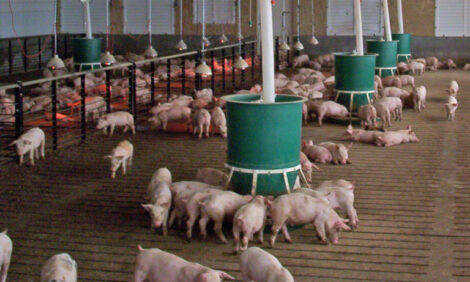



Applying scientific principles to evaluate the effects of BioPlus 2B in piglets under farm conditions
By Peter Kürti, DVM, Chr. Hansen - Whereas research institute trials are essential to prove efficacy and for the purpose of gaining registrations, trials on commercial farms are also necessary because they allow additive treatments to be tested under the types of practical conditions which would be encountered in everyday usage.Introduction
In this trial on a commercial pig farm in Berkshire, England, careful planning and scientific principles were applied to yield statistically valid results. Piglets fed the BioPlus 2B treatment gained significantly more weight and had improved feed conversion ratios than piglets fed untreated feed
Trial set-up
The purpose of the trial was to investigate the effect of BioPlus® 2B, a thermotolerant probiotic feed additive, on piglet production and health status under farm conditions.
Sixty weaned piglets were allocated at random to each of 2 groups (120 piglets in total); one of which was fed untreated feed containing no additive and the other the same feed containing 400g BioPlus 2B per tonne. Both groups were fed a creep ration before weaning and for 12 days post-weaning followed by a starter ration until the end of the trial. Avilamycin and unspecified enzymes are normally included as growth promoters at this farm and were included in creep feed before the trial began. These were removed from all feeds during the trial period. Similarly neomycin sulphate, which is usually added to the water for the first few days after weaning to prevent post-weaning scour, was not administered for this trial.
Litters were split in an attempt to achieve as near as possible two similar groups in relation to weight, proportion of sexes and breed (pigs at this farm are a mixture of Landrace and Large White). This is essential to ensure that any differences observed in a trial are due to treatment and are not due to differences between the starting groups. Equal groups were achieved in this trial by (1) weighing piglets individually in polystyrene boxes on an electronic balance before allocating them to groups and (2) by splitting the piglets by sex and housing them in the same house in 6 pens of 20 piglets per pen, so that both groups comprised one boar pen, one gilt pen and one mixed pen. The trial ran from weaning at 21-27 days of age for three weeks.
The following measurements were made: Pen starting weights on the day the trial began; pen finishing weights on the day the trial finished; total feed intake for each group; feed conversion ratios for each group; mortality within each group (with record of cause, if known); incidence of or days with diarrhoea within each group, veterinary or other treatments for each group.
Results
Piglets in the treated group gained significantly (p<0.005) more liveweight 6.47kg vs. 5.11kg (+26.7%) than piglets in the untreated group (Figure 1). Feed intake was 9.3% less for the group supplemented with the probiotic than for the untreated group.

As a result of the increase in liveweight gain and the decrease in intake, the feed conversion ratio was significantly lower (p<0.05) for the treated group, 1.46 vs 1.05, representing a 28.1% improvement in efficiency over untreated piglets, as shown in Figure 2.
Summary
Those piglets supplemented with BioPlus® 2B showed an increase in daily liveweight gain, a decrease in feed intake and an improved feed conversion ratio in comparison with negative controls. These results favour the use of the supplement as a means of improving weanling production performance and cost efficiency.
This trial also demonstrates that with proper planning and by making sure that starting groups are equal, it is entirely possible to carry out scientifically valid trials on commercial farms, from which the results can be statistically analysed, to yield meaningful results that apply directly to practical farm conditions.
References
This article is the summary of a paper presented at the 2nd International Probiotic Conference by Winckless et al.
November 2006








